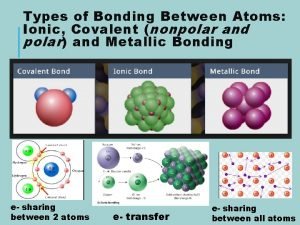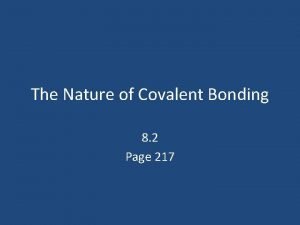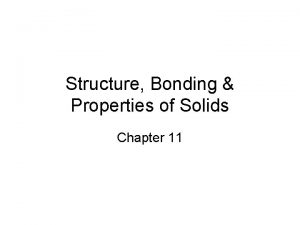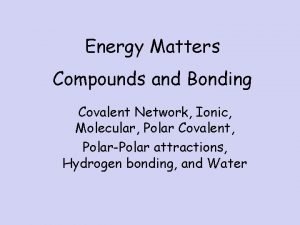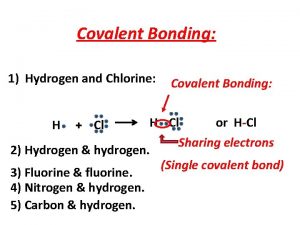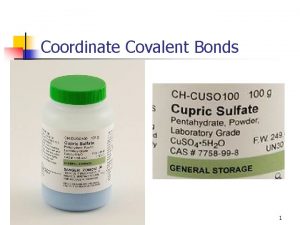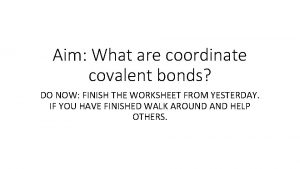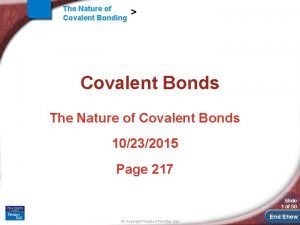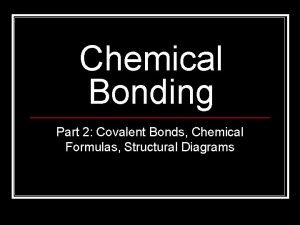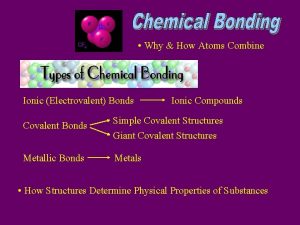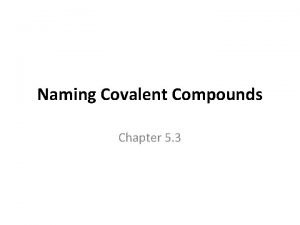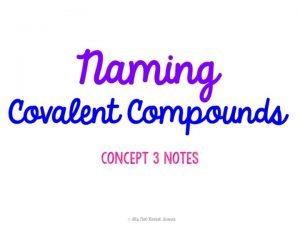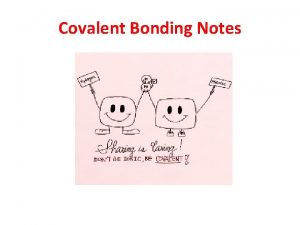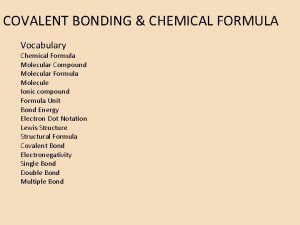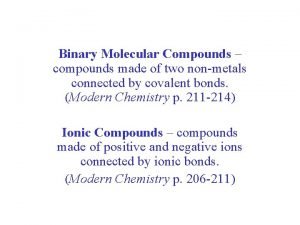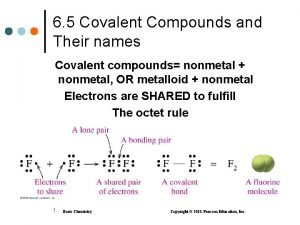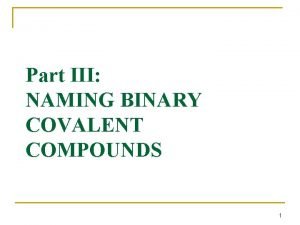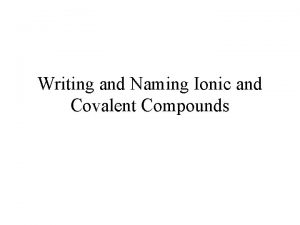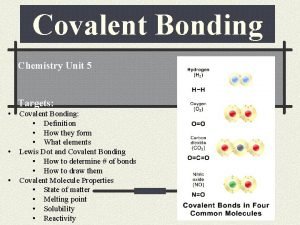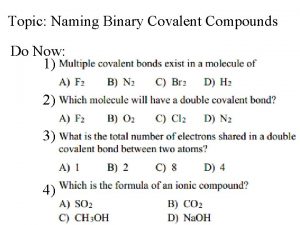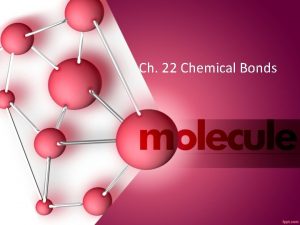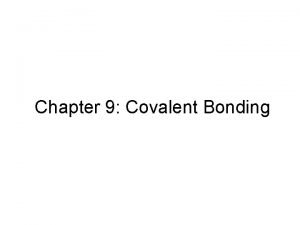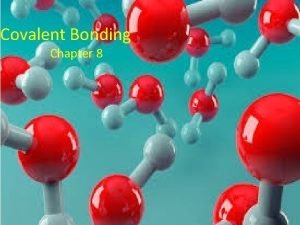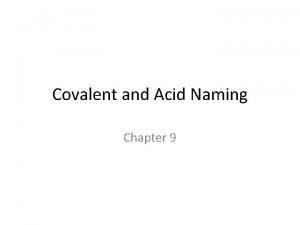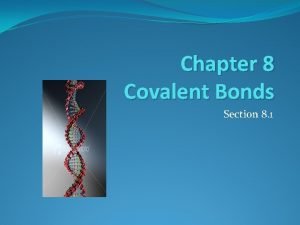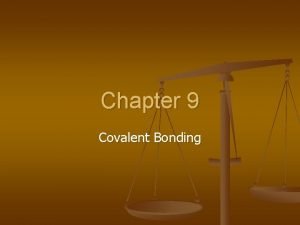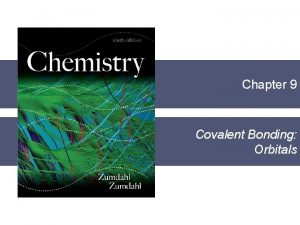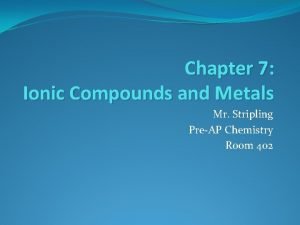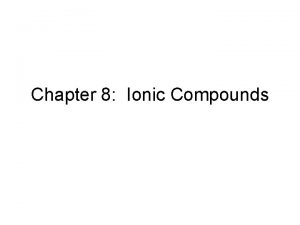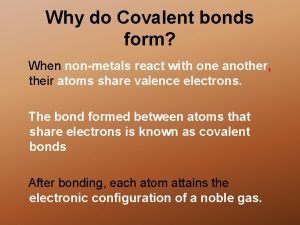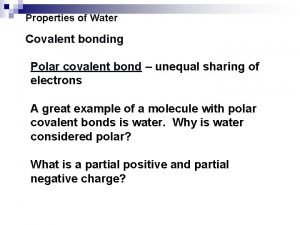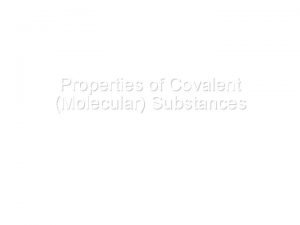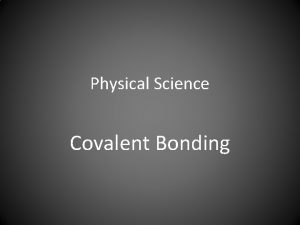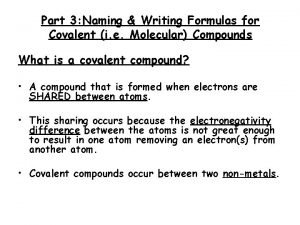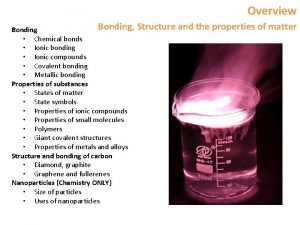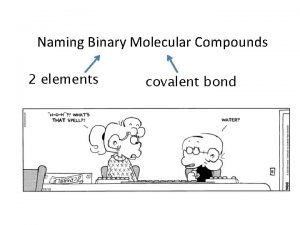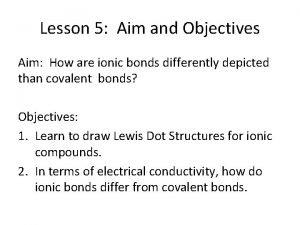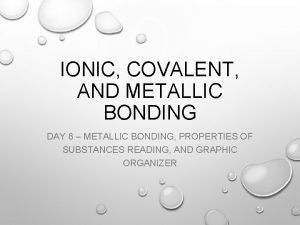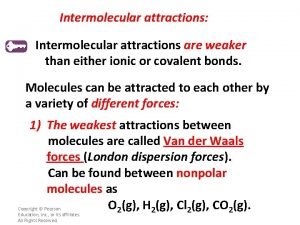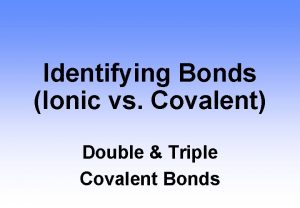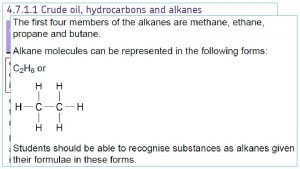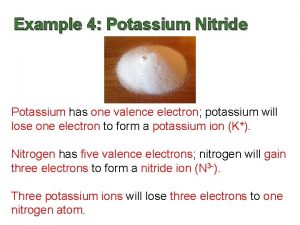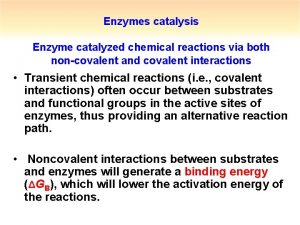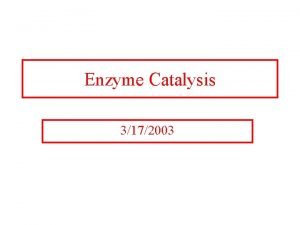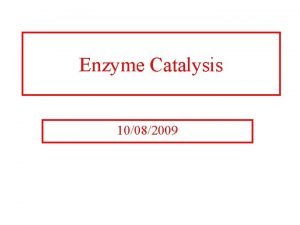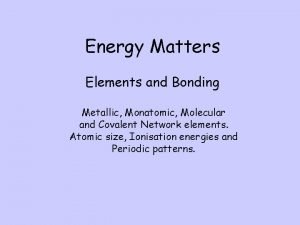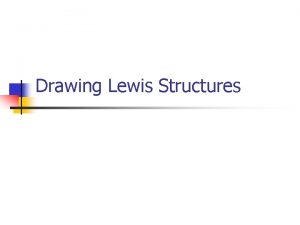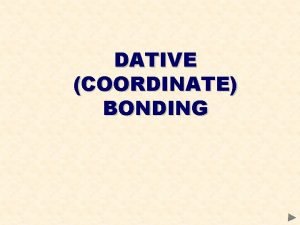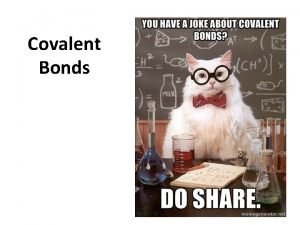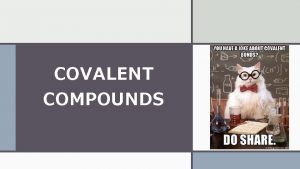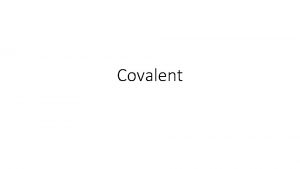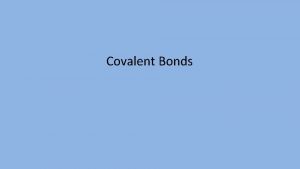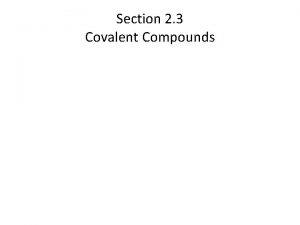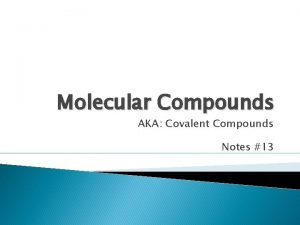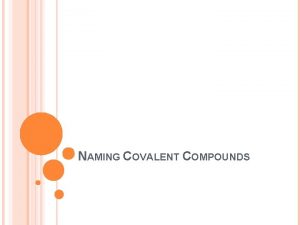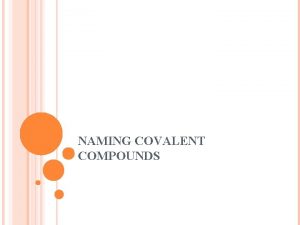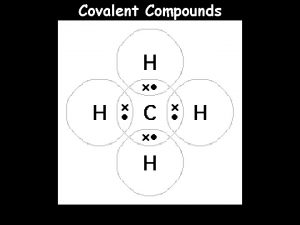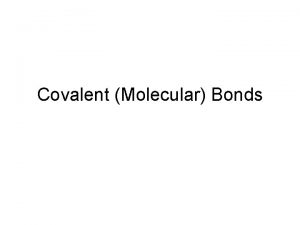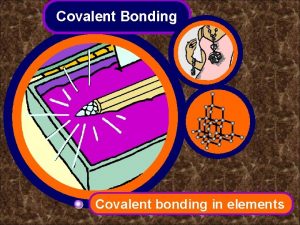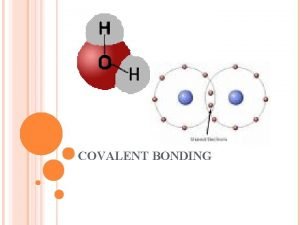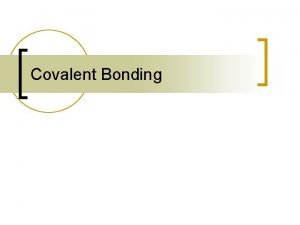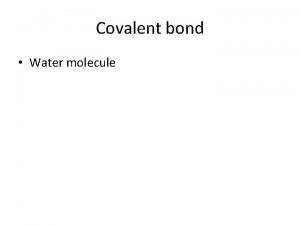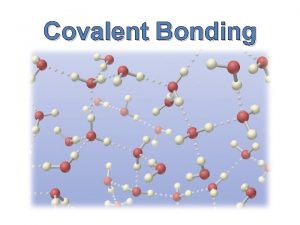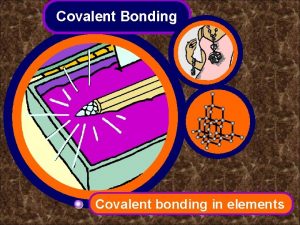CHAPTER 6 COVALENT COMPOUNDS 6 1 Covalent Compounds






































































- Slides: 70

CHAPTER 6: COVALENT COMPOUNDS

6. 1 Covalent Compounds

What is a covalent bond? • Sharing of electrons between atoms • Electron orbitals overlap to form molecular orbitals • Molecular orbitals are the region where the shared electrons move • Covalent bonds are also called molecular bonds.

How is a molecular bond different from an ionic bond? • Ionic Bond: Transfer of electrons • Covalent or Molecular Bond: Sharing of electrons

Bond Length • Average distance between nuclei of two atoms • Not Fixed: atoms vibrate; bond acts like a spring

Bond Energy • Energy needed to break a bond • As bond energy goes up, bond length goes down (inverse relationship) H Br 141. 1 pm Bond energy = 366 k. J/mol H F 91. 7 pm Bond energy = 570

Bond Type Electron Bond s Length Shared Single 2 Long Double 4 Triple 6 Short Bond Energy Low High

Electronegativity • Difference in electronegativities can be used to determine bond type

Predicting Bond Type from Electronegativity Difference • Nonpolar Covalent: Electronegativity Difference < 0. 5 • Polar Covalent: Electronegativity Difference ≥ 0. 5 and ≤ 2. 1 • Ionic: Electronegativity Difference > 2. 1

Types of Covalent Bonds 1. Nonpolar Covalent Bond • Bonding electrons shared evenly • Difference in electronegativity is less than 0. 5 • Examples: C–H H–H

Types of Covalent Bonds 2. Polar Covalent Bond • Bonding electrons not shared evenly • Difference in electronegativity is 0. 5 to 2. 1 • Tend to be stronger than nonpolar covalent bonds • Electrons tend to be closer to more electronegative atoms • Example: H – F

Polar Covalent Bonds • Polar covalent bonds have a dipole. • Dipole: one end has a partial positive charge and the other end has a partial negative charge. • δ+ is used to indicate a partial positive charge • δ- is used to indicate a partial negative charge • Examples:

Ionic Bonds • Metal + Nonmetal • Electronegativity difference is greater than 2. 1 • Example: Li – F

Summary • Nonpolar Covalent: Electronegativity Difference < 0. 5 • Polar Covalent: Electronegativity Difference ≥ 0. 5 and ≤ 2. 1 • Ionic: Electronegativity Difference > 2. 1

Determine if the following compounds are ionic, polar covalent, or nonpolar covalent: 1. Na – F 2. Ca – O 3. C – Cl 4. Al – Cl 5. Br – Br

Determine if the following compounds are ionic, polar covalent, or nonpolar covalent: 1. 2. 3. 4. 5. Na – F = ionic (electronegativity difference = 3. 1) Ca – O = ionic (electronegativity difference = 2. 4) C– Cl = polar covalent (electronegativity difference = 0. 6) Al – Cl = polar covalent (electronegativity difference = 1. 6) Br – Br = nonpolar covalent (electronegativity difference = 0)

Properties of Covalent Compounds 1. 2. 3. 4. 5. Low melting and boiling points Soft and squishy Tend to be flammable Do NOT conduct electricity in water Are NOT very soluble in water

6. 2 Drawing Covalent Compounds: Lewis Structures

Gilbert N. Lewis (1875 – 1946) • Gilbert N. Lewis created Lewis structures • Lewis structures (electron-dot diagrams) • Structural formula for drawing molecules • Dots = electrons • Lines = electron pairs/bonds • Only valence electrons are shown

Lewis Structures • These are examples of Lewis structures H Be C O

1. Lewis Structures of Atoms • A Lewis diagram consists of the element symbol in the center and dots going around it representing the valance electrons. • The dots representing the valance electrons must be evenly distributed around all 4 sides of the symbol. • Group 2 elements and Helium are the exception to the rule of even distribution.

• When placing dots around the element symbol, you should start on the left side and go clock wise until you run out of electrons. • Nitrogen has 5 Valence electrons N N N

Practice Questions Draw a dot diagram of the following elements: • Potassium • Boron • Chlorine • Neon • Lead • Oxygen

K Pb B Cl Ne O

Group 2 and Helium -Group 2 and Helium are the exceptions because their valence electrons are in the first shell. -Therefore the 2 valence electrons for Helium and Group 2 elements need to be put on the same side of the element symbol. He

Why do Lewis structures help us? • These diagrams allow us to understand how atoms will bind based on their valance electron configuration.

Bonding of atoms • When you have unpaired electrons on a side of an atom that atom will want to bond/share electrons with other atoms • This is because all atoms want a full valance shell • Oxygen has two unpaired electrons • Hydrogen has one free electron so 2 H can bond with O, this make H O 2 O H H

2. Drawing Lewis Structures of Compounds • Step 1: Count the total number of valence electrons in the compound. Example: CH 3 I

• Step 2: Draw a Lewis structure for each atom in the compound. Example: CH 3 I 14 valence electrons

• Step 3: Arrange the atoms • Halogen and Hydrogen atoms often bond to only 1 other atom and are usually at the end of the molecule • Carbon is often in the center of the molecule • With the exception of carbon, the atom with the lowest electronegativity is often the central atom Example: CH 3 I 14 valence electrons

• Step 4: Distribute the dots • Distribute the electron dots so that each atom (except H, Be, and B) satisfy the octet rule Example: CH 3 I 14 valence electrons

• Step 5: Draw the bonds • Change each pair of dots that represent a shared pair of electrons to a long dash. Example: CH 3 I 14 valence electrons

• Step 6: Verify the structure • Count the electrons in your structure

Practice 1. ) H 2 S 2. ) NH 3 3. ) BF 3

More Practice 4. ) C 2 H 6 5. ) CH 2 Cl 2 6. ) CH 3 OH 7. ) SCl 2 8. ) CHF 3

3. Lewis Structures with Polyatomic Ions

More Practice

3. Lewis Structures of Compounds with Multiple Bonds C, O, N often form double bonds by sharing 2 pairs of electrons. C, N may even form triple bonds by sharing 3 pairs of electrons.

Practice 1. ) O 2 2. ) C 2 H 4 3. ) CO 2 4. ) N 2

More Practice 5. ) CO 6. ) C 2 H 2 7. ) HCN 8. ) HC 2 Cl 9. ) N 2 F 2

4. Resonance Structures -When a molecule has two or more possible Lewis structures, the two structures are called resonance structures. -Place double-headed arrows between the structure to show that the actual molecule is an average of the two possible states.

Practice 1. ) SO 2 2. ) O 3 3. ) NO 2 -

6. 3 Naming Covalent Molecules

WRITING FORMULAS Covalent Compounds

Covalent Compounds • Formed from 2 nonmetals or 1 metalloid and 1 nonmetal.

Prefix Mono Di Tri Tetra Penta Hexa Hepta Octa Nona Deca Number of Atoms 1 2 3 4 5 6 7 8 9 10

Writing Formulas for Covalent Compounds 1. Write the symbol for the cation. 2. From the prefix, write the number of atoms as a subscript behind the symbol. 3. Write the symbol of the anion. 4. From the prefix, write the number of atoms as a subscript behind the symbol. 5. DO NOT use charges.

Examples 1. Carbon Monoxide = CO 2. Tetraphosphorus decaoxide = P 4 O 10 3. Carbon dioxide 4. Sulfur dioxide

Examples 1. Carbon Monoxide = CO 2. Tetraphosphorus decoxide = P 4 O 10 3. Carbon dioxide = CO 2 4. Sulfur dioxide = SO 2

NAMING COMPOUNDS Covalent Compounds

Covalent Compounds • Formed from a metalloid and a nonmetal or two nonmetals.

Prefix Mono Di Tri Tetra Penta Hexa Hepta Octa Nona Deca Number of Atoms 1 2 3 4 5 6 7 8 9 10

1. Use prefixes: mono, di, tri, tetra, penta, hexa, hepta, octa, nona, and deca. 2. Add a prefix to the cation (from the number of atoms). Exception: the prefix mono is not added to the cation. 4. Add a prefix to the anion (from the number of atoms). 5. Change the ending of the anion to –ide.

Examples 1. P 4 S 10 = tetraphosphorus decasulfide 2. N 2 O = dinitrogen monoxide 3. P 2 O 3 4. IF 5

Examples 1. P 4 S 10 = tetraphosphorus decasulfide 2. N 2 O = dinitrogen monoxide 3. P 2 O 3 = diphosphorus trioxide 4. IF 5 = iodine pentafluoride

6. 4 Molecular Shapes: VSEPR • Objective: 1. To predict the shape of a molecule using VSEPR theory.

VSEPR • V • S • E • P • R Valence Shell Electron Pair Repulsion • VSEPR: theory that predicts some molecular shapes based on the idea that pairs of valence electrons surrounding an atom repel each other

How do we figure out the shape of a molecule? • The shape of a molecule is determined by the valence electrons surrounding the central atom.

The Molecular Shapes… Tetrahedral Bent Trigonal Pyramidal Linear Trigonal Planar

Examples

How do we determine the molecular shape? Step 1: Draw the Lewis structure for the molecule. Example: NH 3

Step 2: Count the number of “things” on the atom you’re interested in (the center atom) • Count atoms and lone pairs, NOT BONDS! Example: NH 3 three atoms one lone pair +________ 4 total “things”

Step 3: Count the number of lone pairs that are on the atom you’re interested in. • Lone pairs on other atoms aren’t important; only count what is directly stuck to the atom you’re interested in. Example: NH 3 one lone pair

VSEPR Flowchart

Practice 1. ) CH 4 2. ) CO 2 3. ) carbon tetrabromide 4. ) phosphorus trichloride 5. ) boron trichloride 6. ) sulfur difluoride

Practice 1. ) CH 4 tetrahedral 2. ) CO 2 linear 3. ) carbon tetrabromide: tetrahedral 4. ) phosphorus trichloride: trigonal pyramidal 5. ) boron trichloride: trigonal planar 6. ) sulfur difluoride: bent

Polarity • A molecule is polar if it has an overall dipole.

How does shape affect polarity? • Examples: • CO 2: linear • No molecular dipole: Not Polar • H 2 O: bent • Molecular dipole: Polar

Are the following molecules polar or nonpolar? 1. ) CF 4 2. ) SF 2 3. ) NF 3 4. ) Be. Cl 2

Are the following molecules polar or nonpolar? 1. ) CF 4 Nonpolar 2. ) SF 2 Polar 3. ) NF 3 Polar 4. ) Be. Cl 2 Nonpolar
 Ionic covalent and metallic bonding
Ionic covalent and metallic bonding Electronegativity trend
Electronegativity trend How many single covalent bonds can halogens form?
How many single covalent bonds can halogens form? Covalent molecular and covalent network
Covalent molecular and covalent network Water is polar or nonpolar
Water is polar or nonpolar Covalent molecular and covalent network
Covalent molecular and covalent network Silicon carbide covalent network
Silicon carbide covalent network Silicon carbide covalent bond
Silicon carbide covalent bond Covalent bond hydrogen and chlorine
Covalent bond hydrogen and chlorine Covalent vs coordinate covalent
Covalent vs coordinate covalent Is co a covalent bond
Is co a covalent bond Nature of covalent bonds
Nature of covalent bonds Bonding and chemical formulas
Bonding and chemical formulas Physical state of covalent compounds
Physical state of covalent compounds Covalent bond
Covalent bond Naming covalent compounds
Naming covalent compounds Covalent compound formula phosphorus pentafluoride
Covalent compound formula phosphorus pentafluoride Chemical formula covalent compounds
Chemical formula covalent compounds Ionic vs covalent compounds
Ionic vs covalent compounds What is the difference between molecule and compound
What is the difference between molecule and compound How to name covalent compounds
How to name covalent compounds Characteristics of covalent bond
Characteristics of covalent bond Is mgs a binary molecular compound
Is mgs a binary molecular compound Covalent compound
Covalent compound How to name covalent compounds
How to name covalent compounds Pentaboron nonahydride formula
Pentaboron nonahydride formula Carbon tetrabromide ionic or covalent
Carbon tetrabromide ionic or covalent Covalent compound hi
Covalent compound hi Covalent salt
Covalent salt Naming binary covalent compounds
Naming binary covalent compounds Is o2ionic or covalent
Is o2ionic or covalent Ionic compounds properties
Ionic compounds properties Chemistry chapter 7 ionic and metallic bonding
Chemistry chapter 7 ionic and metallic bonding Chapter 9 covalent bonding
Chapter 9 covalent bonding Compound vs molecule
Compound vs molecule Ionic covalent names chapter 9
Ionic covalent names chapter 9 Chapter 8 covalent bonding
Chapter 8 covalent bonding Chapter 8 covalent bonding
Chapter 8 covalent bonding Chapter 9 covalent bonding
Chapter 9 covalent bonding Chapter 9 covalent bonding
Chapter 9 covalent bonding Chapter 7 chemical formulas and chemical compounds test
Chapter 7 chemical formulas and chemical compounds test Trinitrogen monosulfide formula
Trinitrogen monosulfide formula Ionic compounds and metals chapter 7
Ionic compounds and metals chapter 7 Chapter 6 chemistry in biology
Chapter 6 chemistry in biology Chapter 7 ionic compounds and metals assessment answer key
Chapter 7 ionic compounds and metals assessment answer key Chapter 6 section 1 atoms elements and compounds
Chapter 6 section 1 atoms elements and compounds Chapter 8 ionic compounds
Chapter 8 ionic compounds How do covalent bonds form
How do covalent bonds form Different types of chemical bonds
Different types of chemical bonds Carbon covalent bonds
Carbon covalent bonds Polar covalent bond in water molecule
Polar covalent bond in water molecule What is a covalent molecular substance
What is a covalent molecular substance Chemical bonding concept map
Chemical bonding concept map Trinitrogen pentaiodide
Trinitrogen pentaiodide Difference between covalent bond and ionic bond
Difference between covalent bond and ionic bond Covalent bond naming
Covalent bond naming Lewis dot structure ionic vs covalent
Lewis dot structure ionic vs covalent Biochemical process
Biochemical process Ionic covalent and metallic venn diagram
Ionic covalent and metallic venn diagram Covalent bond vs hydrogen bond which is stronger
Covalent bond vs hydrogen bond which is stronger Intermolecular force of attraction
Intermolecular force of attraction Lewis dot structure ionic vs covalent
Lewis dot structure ionic vs covalent Covalent bond of ethanol
Covalent bond of ethanol Is potassium nitride ionic or covalent
Is potassium nitride ionic or covalent What is covalent catalysis
What is covalent catalysis What is covalent catalysis
What is covalent catalysis What is covalent catalysis
What is covalent catalysis Ionic covalent and metallic bonds
Ionic covalent and metallic bonds Nnn lewis structure
Nnn lewis structure Dative covalent bond carbon monoxide
Dative covalent bond carbon monoxide Why do atoms want to bond
Why do atoms want to bond

